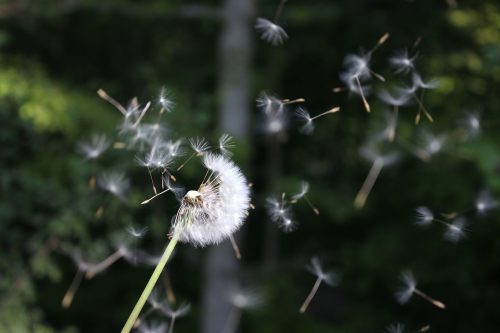Dandelion seeds repurposed as pipettes
Taraxacum officinale, or more commonly known as dandelions, are a well-known nuisance in gardens throughout the world because they infest crops. In a recent development, however, dandelions may have turned over a new leaf, having found a purpose in an unlikely setting: the scientific laboratory.
Last year, a team of high school students, under the guidance of professors from Xi’an Jiaotong University in Xi’an, China, completed an in-depth study about how dandelion seeds can be used as pipettes to create and manipulate microliter-sized droplets, a fifth the size of droplets from eyedroppers. In their research, they were not only able to capture and release consistent droplet sizes repeatedly, but were also able to model the droplet sizes quantitatively based on characteristics of the seeds, such as the length of their hairs.
To use the dandelion seed as a pipette, the researchers first pushed the seed downward against a liquid surface to form a dip, much like the dip when someone stands in the middle of a trampoline. When they pulled the seed upwards out of the liquid, the seed remarkably did not completely separate from it. Instead, the hairs on the seed—which traditionally allowed wind to disperse the seed—formed the shape of a paintbrush tip, enclosing a droplet of the liquid within them.
The key to the consistent droplet sizes—according to Feng Xu, one of the professors involved in the research—lies in a fine balance between two opposing factors: the surface tension of the liquid, and the stiffness of hairs on the seed. Surface tension is an elastic force on the surface of liquids, arising from the attraction of liquid molecules to each other, akin to how the elastic membrane of an inflated balloon keeps the balloon in a spherical shape instead of popping. Surface tension tends to reduce the droplet size. On the other hand, the stiff hairs on the seed tend to increase the droplet size by tending to straighten themselves out, similar to how a plastic ruler snaps back straight after being bent. The combination of these two effects creates a unique balancing point for droplet size, like the stalemate arising when both sides of a tug-of-war are equally strong.
By quantitatively modelling these forces and experimentally verifying their predictions, the researchers were able to optimize the system to hold the largest droplet size. They varied the number, distribution, and length of hairs on the dandelion seed. Xu recounts an unexpected result. “Nature optimized the dandelion seed to give it the capability to capture the maximum amount of liquid,” he said. In hindsight, this makes evolutionary sense, since dandelion seeds need maximal water for optimal growth.
There currently aren’t many tools for creating and manipulating microliter-sized droplets. A significant advantage dandelion seeds have over regular micropipettes is that they are omniphilic, which means that they can be used for both water and oil. Most common materials can only do one or the other, but not both.
That being said, there are certainly restrictions to this new laboratory tool. In order to release a droplet from the dandelion seed, the researchers must place the seed into a liquid with lower surface tension than that of the droplet liquid so that the droplet will be released. This condition limits the contexts in which the method may be used. Still, Xu is optimistic about using the dandelion seed to inspire new synthetic fiber structures—similarly to how Velcro was inspired by the clinging of burrs of the Burdock plant to clothes. For example, some synthetic materials can change their stiffness in response to environmental factors, such as temperature or light. If the fiber structure is manufactured from the dandelion seeds, then just by adjusting those environmental factors—without a need to even contact the structure—we can allow stiffness to win that tug-of-war with surface tension, thereby releasing the droplet anywhere we want. An added advantage of the consistent manufacturing of such fiber structures is that droplet sizes will be more precise than regular micropipettes.
Looking ahead, future directions for this research include the manufacturing of such micro-scale synthetic fiber structures, and the adaptation of this method for other scientific tools. Currently, Xu is pursuing the latter, developing similar fiber structures to manipulate cells instead of liquids, which could potentially change the way human tissues are created. Ultimately, the researchers have uniquely repurposed a common garden weed into a scientific tool.
Sources and Citations
[1] https://en.wikipedia.org/wiki/Taraxacum.
[2] Interview with Professor Feng Xu, Xi’an Jiaotong University, Xi’an, China, on 1/31/18.
[3] “Collective Wetting of a Natural Fibrous System and Its Application in Pump-Free Droplet Transfer”. Y. L. Han, M. Li, Q. Yang, G. Huang, H. Liu, Y. Qin, G. M. Genin, F. Li, T. J. Lu, and F. Xu, Science, 2017 April 4 (https://onlinelibrary.wiley.com/doi/10.1002/adfm.201606607/full).
[4] “New use for a pesky weed”. E. Ebsworth-Goold, ScienceDaily, 2 May 2017. (https://www.sciencedaily.com/releases/2017/05/170502114010.htm).
[5] https://cosmosmagazine.com/technology/10-technologies-inspired-nature.

